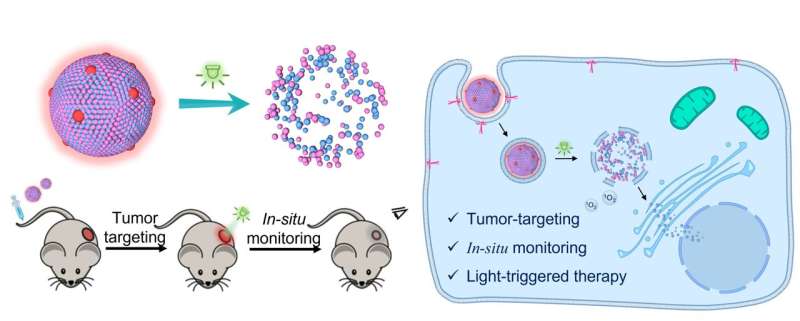A light-controlled nanomedicine for precise drug delivery to treat colorectal cancer

A research team from Department of Pharmacology and Pharmacy, LKS Faculty of Medicine, The University of Hong Kong (HKUMed), has developed a photo-responsive nanomedicine for light-controlled colorectal cancer therapy. The nanoparticles are simply made by self-assembly of a near-infrared dye and a prodrug. After intravenous injection, the nanoparticles can target colon tumors and release drugs to kill cancer cells upon light irradiation. This process can be in-situ monitored by in vivo imaging. The research has been published in Bioengineering & Translational Medicine, and a patent application has been filed based on this work.
Background
According to the statistics from Hong Kong Cancer Registry, colorectal cancer (colon cancer) is the second most common cancer in Hong Kong, accounting for 15.8% of all cancer cases, and there is an upward trend in recent years. Conventional chemotherapy has side effects, including diarrhea, vomiting, hair loss, anemia and so on, as anti-cancer drugs are toxic to normal cells and are usually distributed throughout the body after systemic administration. Therefore, it is necessary to develop a precisely controllable drug delivery technology.
Research methods and findings
Light can activate photo-responsive prodrugs specifically at tumor sites, thus reducing side effects in other tissues. In this study, photo-responsive nanoparticles can be prepared by simply mixing the near-infrared cyanine dye IR783 and the photocleavable chlorambucil prodrug BODIPY-Cb. The nanoparticles have high affinity to caveolin (CAV-1), thus can be efficiently taken up by colorectal cancer cells with high CAV-1 expression. Upon green light irradiation, the prodrug is cleaved, and the nanoparticles dissociate, releasing free chlorambucil. This process can be monitored through fluorescence imaging. In colon cancer-bearing mice, tumor growth was significantly inhibited after administration of the nanoparticles and light treatment, and no obvious side effects were observed.
Significance of the study
This study presents a simple yet effective light-triggerable nanomedicine platform for colorectal cancer treatment, of which the nanomedicine can achieve precise delivery of anti-cancer drugs. This technology has the potentials of treating other local diseases and is expected to be used in clinical study in combination with some optoelectronic devices such as optical fibers.
More information: Kaiqi Long et al, Photoresponsive prodrug‐dye nanoassembly for in‐situ monitorable cancer therapy, Bioengineering & Translational Medicine (2022). DOI: 10.1002/btm2.10311
Provided by The University of Hong Kong




















